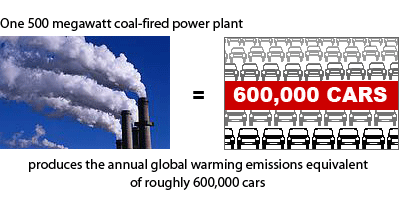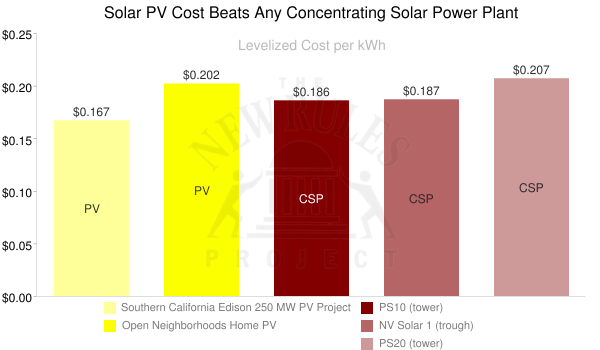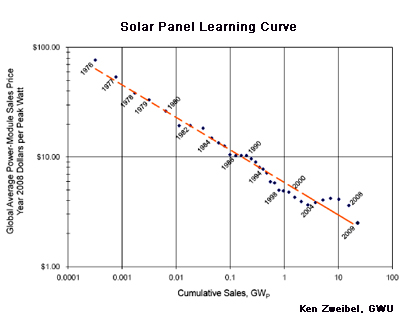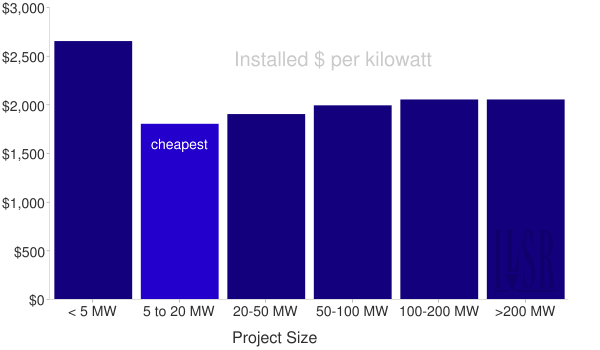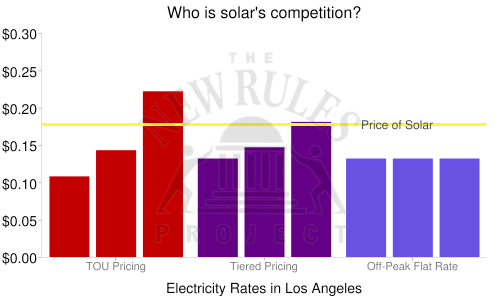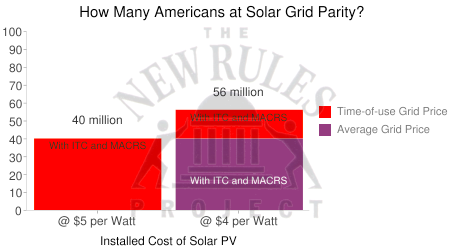A serialized version of ILSR‘s new report, Democratizing the Electricity System, Part 2 of 5. Click for Part 1.
The Economics of Distributed Generation
The falling cost of distributed renewable generation has been one of the key drivers of the transformation of the U.S. electric grid.
The following chart illustrates the cost of power generation calculated by averaging the total lifetime cost over the total electricity generated (“levelized cost”), as estimated by the investment bank, Lazard.[1]Federal incentives cause a significant reduction in the levelized cost of renewable energy, in the form of upfront tax credits as well as ongoing production-based tax credits.
Levelized Cost of Renewable Energy (Lazard):
Levelized Cost of Fossil Energy (Lazard):
Wind, geothermal and biomass are already less expensive than any fossil fuel energy source, when factoring in federal incentives for all three sources.
Solar PV is the most expensive, but has strong prospects for lower price.Already, the average cost for German solar PV (10 to 100 kilowatt (kW) systems) has fallen to $3.70 per Watt,[2] and some 1 MW solar PV systems in the U.S. are being installed at $3.50 per Watt, pushing the lower bound of the prices in the chart.A design charette aimed at reducing balance of system costs found that best practices could reduce solar PV installed costs by nearly 60 percent within five years, not counting further cost reductions in solar modules.[3] At these prices, renewable energy competes very favorably against most new fossil fuel generation.
| (Union of Concerned Scientists) |
Not all costs are covered in this levelized cost comparison.A grid with majority renewable power (from variable sources like wind and solar) will require a different approach than the existing grid. Whereas current generation scheduling, peaking and backup are tailored to a system with large, centralized baseload power plants, a grid with distributed renewable resources will require new load balancing ingenuity.It will be necessary to use smart grid technologies to enable greater demand response and to defer elective electricity use (such as electric vehicle charging) to times with greater supply, and to use energy storage like pumped hydro or batteries to shift surplus production to times of higher demand.It’s also a question of whether any additional costs incurred would be offset by other economic benefits.These issues are discussed later in this report.
Likewise, hidden subsidies for fossil fuels – incentives they once received for technological development, the cost of military operations to secure fossil fuel energy sources, and massive environmental externalities – are also omitted.
The Issue of Scale
| Average Size of U.S. solar PV project: 10 kilowatts |
| Average Size of U.S. wind power project: 80 megawatts |
Even as renewable energy challenges fossil fuels on cost, the average size of renewable energy projects continues to defy the conventional wisdom that bigger is better.The average solar PV system in the U.S. is just 10 kW and the average wind power project is 80 MW.[4] Wind power is often seen as the largest scale renewable energy source, and it provides an interesting lesson.
While the average wind farm size has increased from 35 to 90 MW in the past 10 years, it’s almost entirely due to larger turbines (the average size has jumped from 0.71 MW to 1.74 MW in the same time frame).[5]Wind projects don’t have more turbines, they just use larger ones.While a wind farm of larger turbines may require more total land area (to space them further apart), the amount of occupied land is relatively the same, but delivers more power.
In the same fashion, solar modules have increased in efficiency and quality, allowing for greater electricity output per module.The technological advance actually reduces the need to be bigger.
Because renewable energy projects can lend themselves to smaller scale and geographic dispersion, they encourage the development of a distributed grid.It’s not always the case, however.
Solar Power
There are two electricity technologies, solar PV and solar thermal.Solar PV directly converts sunlight to electricity, and is modular, generating power by interconnecting individual solar modules of approximately 200 Watts into arrays of 5 kW to 50,000 kW (50 MW).Solar PV costs have fallen steadily,[6] with modules representing about half the cost of a solar PV installation, “balance of system,” and labor and installation the remainder.
Concentrating solar thermal generates electricity in several ways, with the common element of a solar concentrator (mirror or lens) used to concentrate sunlight to create heat that will be converted to electricity.Proj
ects are generally 5 MW or larger, with several proposed projects in the U.S. and internationally of several hundred megawatts.Every commercial concentrating solar technology also lends itself to thermal energy storage, because the sun’s heat can be stored in a variety of methods (most involving molten salts) for several hours.
Because solar PV power is often installed on residential rooftops at a fairly small scale, many people believe that it is inherently more expensive than its central-station counterpart, concentrating solar.
The data suggest otherwise.The following chart illustrates the cost of electricity from two sample solar PV projects, one commercial and one residential, as well as the three most cost-effective concentrating solar thermal power plants.[7]Solar PV at commercial scale comes out cheaper.Even smaller scale solar is comparable to large-scale concentrating solar.These figures do not factor in the cost of long-distance transmission, a common additional line item for concentrating solar power plants.
Solar PV v. CSP Costs:
These costs are supported by the lower cost of distributed solar in Germany,[8] as well as recent bids for utility-run distributed solar programs in the United States.[9]
There may be prospects for price decreases for either technology, but it’s hard to see how concentrating solar could win the price war. An oft-shared graphic (below) illustrates the solar PV experience curve, and shows how solar PV module prices have dropped as the total installed capacity has grown (a ten-fold increase installed capacity has generally reduced module prices by half).[10]The small dots show actual module prices, and the large dotted line is the trend.
Solar PV Module Cost Drops by Half for 10-Fold Capacity Increase (Ken Zweibel):
The installed base of solar thermal power plants is just over 1,000 MW, split among several technologies, while solar PV is being installed at a rate of 4,000 MW per year in Germany alone.Since solar thermal projects tend to require years of planning, financing, and construction, it’s unlikely that centralized solar thermal prices will fall as rapidly as decentralized solar PV, supported by this excerpt from a recent Solar Electric Power Association report:[11]
[Concentrating solar power] (CSP) represents over 6,000 MW of the over 15,000 MW of future solar projects that SEPA is tracking, but there are differences in project development between CSP and PV. PV can be built and sub-sections of the larger project can be energized over time, resulting in lower construction risk and balance-sheet impact. CSP projects need to be completed in full before commissioning, a period which takes several years from start to finish.
Even if solar thermal power can keep pace on cost with solar PV, the latter is much more amenable to distributed generation and local ownership and would be preferable even if the costs were similar.
The second economies of scale question for solar power is big solar PV versus small solar PV.Here the data are less conclusive.
The following chart provides an illustration of the installed cost per Watt for solar PV at a range of sizes.The top three lines are historical data from Lawrence Berkeley Labs (LBNL) and the California Solar Initiative (CSI).[12,13]The lowest line represents installed prices reported to the Clean Coalition from their network of installers in California.[14]
Solar PV Economies of Scale:
There are economies of scale for distributed solar, especially for very small (residential scale) systems.Historical U.S. data suggests that the savings from size level off beyond 10 kW, but contemporary installed data suggests that there are two breakpoints in economies of scale, at 10 kW and 1,000 kW.
Data from Germany’s feed-in tariff solar incentive program supports this theory.There is a 25% price differential between the smallest rooftop solar arrays (up to 30 kW) and the largest (over 1000 kW), with 15 percentage points of the savings in the jump from the 100-1000 kW size tranch to the largest one.[15]
In other words, there are valuable economies of scale for projects up to 1 MW.However, there are additional barriers to cost-effectiveness for larger solar PV projects, described in the Solar Electric Power Association’s 2010 Utility Solar Rankings report:[16]
PV projects, which ranged in size from 1-kilowatt residential installations to 48-megawatt power plants, have much shorter planning horizons and project completion times, along with lesser siting, permitting, financing and transmission requirements at these small- and medium-sized scales. However, larger PV and CSP projects (those greater than 50 MW) require overcoming financing, siting/permitting, and transmission barriers that might emerge at these larger sizes.
The trend noted by SEPA is illustrated in a particular example.Sunpower has a 250 MW centralized solar PV power plant planned for the California Valley, secured by a $1 billion federal loan guarantee.The installed cost of the system is $5.70 per Watt, 60% higher than installed costs for 1-20 MW projects.[17]
In short, PV is the preferential technology, and distributed solar is better than centralized.As we discuss later, this has significant implications for the economic benefits of solar power.
Wind Power
The economies of scale of wind power are similar.The power output of a wind turbine increases exponentially with higher wind speeds, as well as with larger diameter blades.Since wind speeds rise quickly as height increases, and taller turbines can host larger blades, utility-scale turbines (generally 1 MW and above) at heights of 80 meters or more are unquestionably more cost-effective than small-scale turbines.
When it comes to multi-turbine projects, however, the data show limited economies of scale.In their 2009 Wind Technologies Market Report for the U.S. Department of Energy,the Berkeley Lab authors showed that costs fell for projects that aggregated a few turbines (5 to 20 MW), but that larger projects had higher levelized costs of operation.[18] The following chart (redrawn from the report) illustrates:
Wind Projects 5 – 20 MW Have Lowest Cost per Kilowatt:
The lesson from the report is that wind projects built at a smaller scale capture most of the construction and project economies of scale, but also may avoid diseconomies of scale that affect larger projects.These diseconomies can include higher financing costs due to multi-billion dollar project costs, time and money costs for new transmission infrastructure, and legal costs to secure the land rights for a large project as well as the cost of overcoming local resistance.In Germany, home to some of the most effective renewable energy policies in the world, more than half of its 27,000 MW of wind are in projects 20 MW and smaller.[19] It’s no coincidence that half of Germany’s wind power capacity is also locally owned by farmers and cooperatives.[20]
There are also some potential economies of operation and maintenance, although these shrink as wind projects become more ubiquitous and services are more broadly available.
Is Distributed Solar Competitive at Retail?
For many distributed projects, the issue is not a comparison to other large-scale power plant costs or economies of scale, but how distributed generation compares to grid electricity.The liability in such comparison is that grid electricity is mostly from old fossil fuel power plants that were paid off years ago and that generate significant pollution (including carbon emissions).Furthermore, the price of grid electricity is not static (it’s gone up 3.8% per year since 2000).[21]However, many prospective customers use their existing electric bill when considering solar, so the comparison has merit.
Consider a residential solar PV system installed in Los Angeles.A local buying group negotiated a price of $4.78 per Watt, equivalent to 17.9 cents per kilowatt-hour (kWh) with federal incentives. Since the average electricity price in Los Angeles is 11.5 cents, solar doesn’t appear to compete.Or does it?
The following chart illustrates the difficulty in determining whether solar has reached “grid parity” (e.g. the same price as electricity from the grid).
Solar & Grid Parity – What is Solar’s Competition?
In Los Angeles, there are three sets of electricity prices.From October to May (off-season), all pricing plans have a flat rate per kWh and total consumption.During peak season (June to September), however, the utility offers two different pricing plans: time-of use pricing and tiered pricing. Time-of-use pricing offers lower rates – 10.8 cents – during late evening and early morning hours, but costs as much as 22 cents per kWh during peak hours.Prices fluctuate by the hour.Tiered pricing offers the same, flat rate at any hour of the day, but as total consumption increases the rate does as well.For monthly consumption of 350 kWh or less, the price is 13.2 cents.From 350 to 1,050 kWh, the price is 14.7 cents.Above 1,050 kWh, each unit of electricity costs 18.1 cents.
A very rough calculation of the expected time of day production of a solar array in Los Angeles finds that the average value of a solar-produced kWh is 15.1 cents over a year.[22] That suggests that solar power is not yet at grid parity, even with time-of-use pricing.A similar value was found when examining time-of-use pricing in PG&E’s service territory.[23]A more robust analysis with assumptions about higher levels of on-site electricity use during peak hours could change these estimates.
There are other considerations, as well.With a grid connected system, the most common policy governing the connection is net metering.It allows self-generators to roll their electricity meter backward as they generate electricity, but there are limits.Users typically only get a credit for the energy charges on their bill, and not for fixed charges utilities apply to recover the costs of grid maintenance (and associated taxes and fees). Producing more than is consumed onsite can mean giving free power to the utility company.So even if a solar array could produce all the electricity consumed on-site, the billing arrangement would not allow the customer to zero out their electricity bill.Some policies, like CLEAN contracts, eliminate this problem.
Based on ILSR’s analysis, solar PV is becoming competitive with average grid electricity prices in select areas of the United States.As prices fall to $4 per Watt,
solar PV projects that can take advantage of the federal tax credits and accelerated depreciation – an incentive only available to commercial operations – would compete favorably with average grid electricity prices in New York, San Francisco and Los Angeles (representing 40 million Americans).
Under a time-of-use pricing plan (where prices could be 30% higher during hours with good sunshine, as in Los Angeles), the equation changes.An additional 16 million Americans could use solar PV (along with both federal incentives) to beat their grid electricity price at an installed cost of $4 per Watt.Even at $5 per Watt, 40 million Americans could use solar PV and federal incentives to best their utility’s time-of-use electricity rate.
Falling Solar Costs Reach Grid Parity with Time-of-Use Pricing:
As noted above, this grid parity calculation assumes that solar producers can use federal depreciation, an incentive worth as much as 25% of the project cost and only available to businesses or to homeowners who lease their solar panels.Without any federal incentives, solar PV would have to be installed at approximately $2.40 per Watt to be at grid parity for 56 million Americans.
In the current environment of incentives, distributed solar is nearing a cost-effectiveness threshold, when it will suddenly become an economic opportunity for millions of Americans.
To read more about democratizing the electricity system, click through:
References
- Lazard.Levelized Cost of Energy Analysis, Version 3.0.(Lazard, February 2009).Accessed 2/25/11 at http://tinyurl.com/49gc24l.
- Farrell, John.Really, Really Astonishingly Low Distributed Solar PV Prices from German Solar Policy.(Energy Self Reliant States blog, 4/27/11).Accessed 6/13/11 at http://tinyurl.com/3lbsa85.
- Farrell, John.Distributed Solar PV Beats Grid Prices with “Balance of System” Cost Reductions.(Energy Self-Reliant States blog, 3/14/11).Accessed 3/22/11 at http://tinyurl.com/6zz4y9k.
- Solar data from the California Solar Initiative.Wind data from the 2009 Wind Technologies Market Report.
- Wiser, Ryan and Mark Bolinger.2009 Wind Technologies Market Report.(U.S. Department of Energy, August 2010).Accessed 01/11/2011 at http://tinyurl.com/4bq67uc.
- With the exception of the 2008 silicon price shock.
- Farrell, John.Will Solar PV Kill Concentrating Solar Thermal Power?(Energy Self Reliant States blog, 10/19/10).Accessed 01/11/2011 at http://tinyurl.com/66ygtlh.
- Farrell, John.Really, Really Astonishingly Low Distributed Solar PV Prices from German Solar Policy.(Energy Self Reliant States blog, 4/27/11).Accessed 6/13/11 at http://tinyurl.com/3lbsa85.
- Kraemer, Susan.SCE Buys 20 Years of Solar Power for Less than Natural Gas.(Clean Technica, 2/1/11).Accessed 02/02/2011 at http://tinyurl.com/4zxxhej.
- Solar Electricity Costs.(solarcellcentral.com, undated).Accessed 2/25/11 at http://tinyurl.com/4olblyz.
- Campbell, Becky and Mike Taylor.2010 SEPA Utility Solar Rankings.(SEPA, June 2011).Accessed 6/14/11 at http://tinyurl.com/3t3kdn3.
- Barbose, Galen, et al.Tracking the Sun III: The Installed Cost of Photovoltaics in the U.S. from 1998-2009.(Lawrence Berkeley National Laboratory, December 2010).Accessed 6/10/11 at http://tinyurl.com/68a7pnf.
- Cost by System Size.(California Solar Statistics website).Accessed 6/10/11 at http://tinyurl.com/6joq6kp.
- Lewis, Craig.Driving Clean Local Energy and Delivering the New Energy Economy.(Four Corners Green Living Expo Presentation on CLEAN Programs, April 2011).Accessed 6/9/11 at http://tinyurl.com/3rj6y6x.
- Wikipedia contributors.Feed-in tariff.(Wikipedia, The Free Encyclopedia, last revised 6/9/11).Accessed 6/13/11 at http://tinyurl.com/3j897b5.
- Campbell, Becky and Mike Taylor.2010 SEPA Utility Solar Rankings.(SEPA, June 2011).Accessed 6/14/11 at http://tinyurl.com/3t3kdn3.
- Conversation with Tony Clifford of Standard Solar, 6/14/11.
- Also, Wesoff, Eric.SunPower and NRG’s 250 MW Solar Project Closer to Reality.(Greentechsolar, 4/12/11).Accessed 6/14/11 at http://tinyurl.com/3qwvye7.
- Wiser, Ryan and Mark Bolinger.2009 Wind Technologies Market Report.(U.S. Department of Energy, August 2010).Accessed 01/11/2011 at http://tinyurl.com/4bq67uc.
- Farrell, John.Distributed Wind Power Scales, Too.(Energy Self-Reliant States blog, 1/28/11).Accessed 2/28/11 at http://tinyurl.com/5us9d8n.
- Koening, Dr. Ingo.Money Makes the Blades Go Round.(Presentation at the 7th Canadian German Wind Energy Conference, 2/8/11).Accessed 6/15/11 at http://tinyurl.com/6zzxx2z.
- Average Retail Price of Electricity to Ultimate Customers: Total by End-Use Sector.(Energy Information Administration, 3/11/11).Accessed 6/21/11 at http://tinyurl.com/3px7t7q.
Data for time of day production taken from Borenstein, Severin.Valuing the Time-Varying Electricity Production of Solar Photovoltaic Cells.(Center for the Study of Energy Markets, March 2005).Accessed 3/7/11 at http://bit.ly/eU9zYK. - Using PG&E E-6 residential tariff for area T (coastal California), assuming baseline level consumption for a customer without electric heat.



